By David C. Read, MPH, MBA
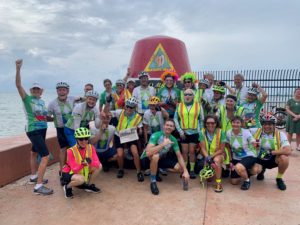 I rounded the corner and there it was – the Southernmost Point marker in Key West. I had seen it in lots of photos and postcards over the years, but now the big red buoy was about 500 yards away and we were finally closing in on it. In a few minutes our adventure would be over, so I slowed my bike a bit to take it all in. The date was Friday, November 15, 2019.
I rounded the corner and there it was – the Southernmost Point marker in Key West. I had seen it in lots of photos and postcards over the years, but now the big red buoy was about 500 yards away and we were finally closing in on it. In a few minutes our adventure would be over, so I slowed my bike a bit to take it all in. The date was Friday, November 15, 2019.
The road to get there started nine years earlier at the Canadian border in Calais, Maine. Our group of 25 cyclists pushed off from the New Brunswick border for a weeklong ride to Portland, ME on the East Coast Greenway (ECG) route. Sending us off were representatives of the Trans Canada Trail who, like the ECG, is working toward a long-distance trail across their expansive country. At the border crossing together we were holding both an American flag and a Canadian flag. We clicked off a few photos and they set us off on our journey.
Several of the riders that first year were board members or volunteers for the advocacy organization for the trail, the East Coast Greenway Alliance (ECG Alliance), but most of us just knew our local sections of the ECG in the states we were from. A couple of times a year the ECG Alliance sends out updates on new sections of trail that open but the announcement in 2010 for the ribbon cutting of the Down East Sunrise Trail in northern Maine got many people’s attention. At a worthy 88 miles, it motivated us to get up there and experience this rail-to-trail beauty. And since the trail starts so close to the official northern terminus of the ECG in Calais, we decided to begin there. The first, and what we then thought would be the only ride, would take us to Portland, ME.
 The soon-to-be annual ride wasn’t referred to as the “Week-A-Year” or WAY tour until we had completed year two which went from Portland to Hartford, CT. We then decided that we would continue heading south on the ECG and wherever we left off at the end of the previous year’s ride would become the start of the next section of the ECG. One night at dinner, as excitement built for continuing this ride, I reminded the group that “it was a bit too early to decide if you want salt or no-salt on your margarita in Key West.” We were still in Connecticut at that point and didn’t want us getting ahead of ourselves – not so much in miles, but in the years to cycle the whole route – one week a year.
The soon-to-be annual ride wasn’t referred to as the “Week-A-Year” or WAY tour until we had completed year two which went from Portland to Hartford, CT. We then decided that we would continue heading south on the ECG and wherever we left off at the end of the previous year’s ride would become the start of the next section of the ECG. One night at dinner, as excitement built for continuing this ride, I reminded the group that “it was a bit too early to decide if you want salt or no-salt on your margarita in Key West.” We were still in Connecticut at that point and didn’t want us getting ahead of ourselves – not so much in miles, but in the years to cycle the whole route – one week a year.
Soon word got out about the WAY tour and before long our group grew to 40 cyclists from different backgrounds and different states and of different ages. This was a non-spandex crowd for sure. There was even an energetic yellow lab named Sadie that joined us a couple of years. She would patiently ride in a bike trailer and hop out for a run on her leash next to the bike when we slowed down. Some of us humans are still “working-stiffs” so we couldn’t blow through several weeks of vacation on a bike (and stay married) to do the entire ECG in one or even three trips. Amazing bike tours like those would have to wait until retirement for many of us.
 The WAY tour wasn’t too punishing a trek compared to some and averaged about 350 miles over six days of riding. The ECG is not a homogenous route – you see rural, urban and suburban landscapes along the way. Each year we’d rent a box truck so a non-riding spouse could cart our luggage. We also all downloaded the same mapping app that would guide us on the route for when we were day-dreaming or looking at the scenery. It would chirp at us if we veered off course or took a wrong turn.
The WAY tour wasn’t too punishing a trek compared to some and averaged about 350 miles over six days of riding. The ECG is not a homogenous route – you see rural, urban and suburban landscapes along the way. Each year we’d rent a box truck so a non-riding spouse could cart our luggage. We also all downloaded the same mapping app that would guide us on the route for when we were day-dreaming or looking at the scenery. It would chirp at us if we veered off course or took a wrong turn.
The group believes in the mission and goal of a completed ECG and since so many of us were already donors we made the WAY tour a fundraiser for the ECG Alliance to help the organization continue its work to make the completed trail a reality. Each year word spread about the WAY tour in cycling communities and interest increased in joining the group. Between the fundraising aspect, and with the limited lodging options in some areas, the size of the group was kept manageable. The exact number of miles ridden each day was usually dictated by the accommodation options that could handle three dozen-plus sweaty souls and their bikes. When the tour finished each year, planning would soon start for the following year. Much of the planning included “So how will I get my bike from home to the next starting point” and that became part of the annual logistical puzzle. As the years went on, the WAY became more of an annual reunion.
 The tour started only a few years after the 2008 financial crisis. For some of the small towns on our route, we were like a mini-economic stimulus package that rolled in. Our group stayed in either several close-by inns or, when possible, all together in larger hotels. We ate out at restaurants we could walk to and frequented local pubs. Other than their bikes and a few clothes, the only other thing touring cyclists usually brought with them is their wallets. In the larger cities our group was sometimes welcomed by the local politicians and press as word continued to spread about the WAY tour. During one happy hour while in Annapolis Maryland, the Director of Tourism stopped by to say hello. Her comment to us: “Oh yeah, I’ve already done the math on how much (money) this group is dropping in my town tonight.” In smaller towns, the economic benefit was even more significant – occasionally there would be more WAY riders in some restaurants than there would be locals.
The tour started only a few years after the 2008 financial crisis. For some of the small towns on our route, we were like a mini-economic stimulus package that rolled in. Our group stayed in either several close-by inns or, when possible, all together in larger hotels. We ate out at restaurants we could walk to and frequented local pubs. Other than their bikes and a few clothes, the only other thing touring cyclists usually brought with them is their wallets. In the larger cities our group was sometimes welcomed by the local politicians and press as word continued to spread about the WAY tour. During one happy hour while in Annapolis Maryland, the Director of Tourism stopped by to say hello. Her comment to us: “Oh yeah, I’ve already done the math on how much (money) this group is dropping in my town tonight.” In smaller towns, the economic benefit was even more significant – occasionally there would be more WAY riders in some restaurants than there would be locals.
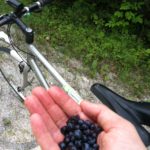 The one thing that did morph over the years was the time of year we rode. In 2011 the ride started in August in northern Maine. During that time of year, for miles on either side of the trail, you can see and pick wild blueberries. The further south we got, the summer rides gave way to riding in early fall. Convenience stores with large walk-in beer refrigerators became quick stops to cool off. By the time we got south of the Mason-Dixon Line, the heat had us riding in October. But that too had its challenges.
The one thing that did morph over the years was the time of year we rode. In 2011 the ride started in August in northern Maine. During that time of year, for miles on either side of the trail, you can see and pick wild blueberries. The further south we got, the summer rides gave way to riding in early fall. Convenience stores with large walk-in beer refrigerators became quick stops to cool off. By the time we got south of the Mason-Dixon Line, the heat had us riding in October. But that too had its challenges.
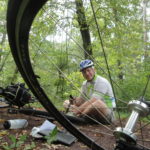 Like many bike tours, all things didn’t go as planned. A long-distance tour can be a metaphor for life. For me it was two days in a row during one year’s ride, in an unnamed state (without a bottle bill and apparently a sparse street sweeping schedule!). I had six flat tires one day and seven flats the next! I quickly went through my spare tubes, my patch kit and the spare tubes of a few fellow cyclists, who on those days had made the mistake of riding with me. One of my riding partners said to me, “Don’t you want to give up? Don’t you want to call the truck for a pick-up?” I replied “No way, I work at a cancer research hospital – 13 flats is nothing.” Near the end of that second day, I spied a bike shop on the route and restocked my tube supply and the tubes donated by my friends, and replaced my tire rather than worrying about any elusive glass that still might be hiding in the rubber.
Like many bike tours, all things didn’t go as planned. A long-distance tour can be a metaphor for life. For me it was two days in a row during one year’s ride, in an unnamed state (without a bottle bill and apparently a sparse street sweeping schedule!). I had six flat tires one day and seven flats the next! I quickly went through my spare tubes, my patch kit and the spare tubes of a few fellow cyclists, who on those days had made the mistake of riding with me. One of my riding partners said to me, “Don’t you want to give up? Don’t you want to call the truck for a pick-up?” I replied “No way, I work at a cancer research hospital – 13 flats is nothing.” Near the end of that second day, I spied a bike shop on the route and restocked my tube supply and the tubes donated by my friends, and replaced my tire rather than worrying about any elusive glass that still might be hiding in the rubber.
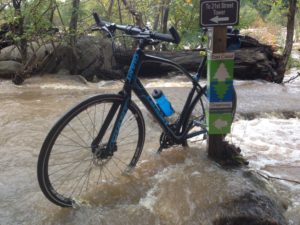 Year 5 there was an impassable bridge out along the route which required a long detour. Year 6 we were riding just after the tail of Hurricane Joaquin and, after 70 miles of getting soaked with torrential rain, there was water rushing though our spokes on the trail in Richmond, VA. Year 7 was the only ride we didn’t complete. That tour was expected to finish in Myrtle Beach, SC but Hurricane Matthew was bearing down on the Carolinas. After a few days of riding, we were stopped just short of Wilmington, NC and needed to evacuate out of the area. So the following year we cycled back from Wilmington to the point on the route where we stopped the year before to start the year 8 ride. Two back-to-back hurricanes in October would chase the WAY tour into November for the remaining couple of years.
Year 5 there was an impassable bridge out along the route which required a long detour. Year 6 we were riding just after the tail of Hurricane Joaquin and, after 70 miles of getting soaked with torrential rain, there was water rushing though our spokes on the trail in Richmond, VA. Year 7 was the only ride we didn’t complete. That tour was expected to finish in Myrtle Beach, SC but Hurricane Matthew was bearing down on the Carolinas. After a few days of riding, we were stopped just short of Wilmington, NC and needed to evacuate out of the area. So the following year we cycled back from Wilmington to the point on the route where we stopped the year before to start the year 8 ride. Two back-to-back hurricanes in October would chase the WAY tour into November for the remaining couple of years.
And there were also a couple of crashes, one serious enough to require the cyclist to devote most of a year to rehab before he could get back on a bike again. But those incidents only motivated him, and all of us, to press on with the long-term work of the ECG Alliance – to develop a 100% safe off-road 3,000 mile trail along the eastern seaboard. Once fully completed, the ECG will be a sister to the Appalachian Trail, but one that is bikeable and ADA accessible for most of the route. It took decades to build the Appalachian Trail so, as ECG advocates, we know we’ll have to be in this for the long run. Many on the tour realize that this trail is not for us – it’s for our kids and grandkids.
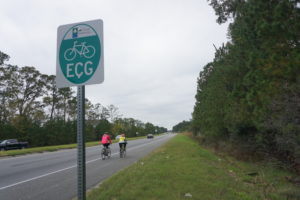 There are so many trails that make up the ECG but, in my opinion, the state of Georgia has the crown jewel of them all. The Spanish Moss Trail with its cool white cement surface was a welcome respite from the miles of black asphalt that preceded it. The Spanish Moss Trail was a ribbon of perfection and one that arrived at just the right time of the ride that day when we needed a break from hot pavement. But while we are speaking of the state of Georgia, there’s a big BUT here; the Peach State also has one of the more challenging segments of the ECG route. Riding along the Route 17 highway for long stretches is not ideal. Cyclists have three options here, none of them good. The first is to try to continually thread your front wheel in the 8 inches between the edge of the road and the rumble strip. Over time this requires more concentration than one would expect, or than should be needed on a bike vacation. The second option is a bone-jarring ride on the rumble strip. This experience is a bit like a bucking bronco ride and you could measure compliance with this option in seconds and feet. The third option is for cyclists to “take the lane”. This would only be safe if you had at least a half-dozen cyclists with you to help with visibility of the group for tractor trailer trucks passing in the left lane.
There are so many trails that make up the ECG but, in my opinion, the state of Georgia has the crown jewel of them all. The Spanish Moss Trail with its cool white cement surface was a welcome respite from the miles of black asphalt that preceded it. The Spanish Moss Trail was a ribbon of perfection and one that arrived at just the right time of the ride that day when we needed a break from hot pavement. But while we are speaking of the state of Georgia, there’s a big BUT here; the Peach State also has one of the more challenging segments of the ECG route. Riding along the Route 17 highway for long stretches is not ideal. Cyclists have three options here, none of them good. The first is to try to continually thread your front wheel in the 8 inches between the edge of the road and the rumble strip. Over time this requires more concentration than one would expect, or than should be needed on a bike vacation. The second option is a bone-jarring ride on the rumble strip. This experience is a bit like a bucking bronco ride and you could measure compliance with this option in seconds and feet. The third option is for cyclists to “take the lane”. This would only be safe if you had at least a half-dozen cyclists with you to help with visibility of the group for tractor trailer trucks passing in the left lane.
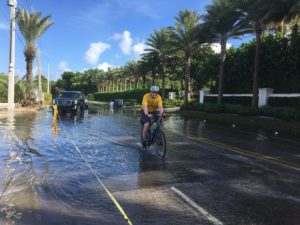 Over the years we got to see the effects of climate change, up close and personal. A section of the trail along the Connecticut coast had been wiped out by Hurricane Sandy, there were houses being built on stilts in New Jersey, and we came across a once-handsome sailboat in Florida. The only issue was that the boat was not in the water; it had washed up on the side of the trail, likely a couple of years ago, and was damaged beyond repair. One of the more apparent impacts of global warning we saw firsthand on the tour was the tidal flooding that now occurs on a regular basis in Miami. There were sections on several roads where we found ourselves riding slowly through six inches of water during a normal high tide.
Over the years we got to see the effects of climate change, up close and personal. A section of the trail along the Connecticut coast had been wiped out by Hurricane Sandy, there were houses being built on stilts in New Jersey, and we came across a once-handsome sailboat in Florida. The only issue was that the boat was not in the water; it had washed up on the side of the trail, likely a couple of years ago, and was damaged beyond repair. One of the more apparent impacts of global warning we saw firsthand on the tour was the tidal flooding that now occurs on a regular basis in Miami. There were sections on several roads where we found ourselves riding slowly through six inches of water during a normal high tide.
 In the end, after so many miles of riding, the good memories easily outnumbered the bad. I mostly loved riding over the more than one hundred bicycle pedestrian bridges that are quiet and car-free. The Scarborough Marsh bridge on the Eastern Trail in Maine, the Ipswich River Bridge in Massachusetts with kayaks navigating the water below, and the covered bridge on the Hop River Trail in Connecticut come to mind. Some other highlights were riding down the Mall in Washington, DC and stopping at the large granite steps of the Lincoln Memorial for a photo. One of my favorite memories was riding over a long bridge in Florida where I saw a sailfish jump out of the bay a couple of times.
In the end, after so many miles of riding, the good memories easily outnumbered the bad. I mostly loved riding over the more than one hundred bicycle pedestrian bridges that are quiet and car-free. The Scarborough Marsh bridge on the Eastern Trail in Maine, the Ipswich River Bridge in Massachusetts with kayaks navigating the water below, and the covered bridge on the Hop River Trail in Connecticut come to mind. Some other highlights were riding down the Mall in Washington, DC and stopping at the large granite steps of the Lincoln Memorial for a photo. One of my favorite memories was riding over a long bridge in Florida where I saw a sailfish jump out of the bay a couple of times.
 The wildlife we saw over our nine-year southerly trek, of course, also changed. In northern Maine we saw a black bear lumbering across the trail about a tenth of a mile ahead of us. In Connecticut we shared the trail with some equestrians whose horses didn’t flinch, seemingly very used to cyclists passing by. In South Carolina we saw our first alligator mostly submerged in a soggy ditch next to the trail. For a northerner like me, it was fascinating to see this prehistoric holdover on our route. Those sightings only increased the further south we rode and by the end no one was stopping for gator photos, just passing them without a mention. We had several ferry crossings across wide rivers along the route. During the crossing of the St. John’s River leaving Georgia, we saw wild horses grazing on Cumberland Island, and we were escorted into Florida by dolphins jumping alongside the boat.
The wildlife we saw over our nine-year southerly trek, of course, also changed. In northern Maine we saw a black bear lumbering across the trail about a tenth of a mile ahead of us. In Connecticut we shared the trail with some equestrians whose horses didn’t flinch, seemingly very used to cyclists passing by. In South Carolina we saw our first alligator mostly submerged in a soggy ditch next to the trail. For a northerner like me, it was fascinating to see this prehistoric holdover on our route. Those sightings only increased the further south we rode and by the end no one was stopping for gator photos, just passing them without a mention. We had several ferry crossings across wide rivers along the route. During the crossing of the St. John’s River leaving Georgia, we saw wild horses grazing on Cumberland Island, and we were escorted into Florida by dolphins jumping alongside the boat.
Bicycle touring can be a humbling experience on many fronts. It wasn’t until riding by many lawn signs in the rural areas that I got my first hint of how the 2016 Presidential election would turn out. So to my increased awareness of “I’m not fast enough”, “I’m not in shape enough”, etc., I now realized “I am politically clueless.”
 During our almost decade together, our lives changed too. My mandatory lobster roll during every day of the ride evolved into a burrito as I became a fully converted vegetarian. With my long-awaited margarita in Key West, I ordered a salad. We of course aged together over the years with one of the riders turning 80 a few days before the 9th and final ride. And there was no judgment in this group – by the end of the WAY tour, several of the riders had transitioned to e-bikes. Most importantly, they were still out on the trails and roads with us.
During our almost decade together, our lives changed too. My mandatory lobster roll during every day of the ride evolved into a burrito as I became a fully converted vegetarian. With my long-awaited margarita in Key West, I ordered a salad. We of course aged together over the years with one of the riders turning 80 a few days before the 9th and final ride. And there was no judgment in this group – by the end of the WAY tour, several of the riders had transitioned to e-bikes. Most importantly, they were still out on the trails and roads with us.
 In the end and in our era, we got it done. Over the nine years there were a few bikes that broke down and a few of the riders had joints replaced. With a new starting point every year, new travel logistics had to be figured out annually. Some of those didn’t work out perfectly including the occasional missed flight. But these were mere inconveniences or, as my son likes to remind me, are “first world problems”. But what was clear at that big red buoy in Key West, with hugs and tears, is that so many friendships were made with folks from other states – and all because of a bike ride. It’s clear from the continuing post-ride emails and social media chatter that these friendships are lasting long after the tour. Flat tires, missed flights and hurricane evacuations – it was all so worth it.
In the end and in our era, we got it done. Over the nine years there were a few bikes that broke down and a few of the riders had joints replaced. With a new starting point every year, new travel logistics had to be figured out annually. Some of those didn’t work out perfectly including the occasional missed flight. But these were mere inconveniences or, as my son likes to remind me, are “first world problems”. But what was clear at that big red buoy in Key West, with hugs and tears, is that so many friendships were made with folks from other states – and all because of a bike ride. It’s clear from the continuing post-ride emails and social media chatter that these friendships are lasting long after the tour. Flat tires, missed flights and hurricane evacuations – it was all so worth it.
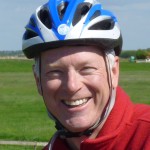 David is a board member of the 15-state East Coast Greenway (ECG) project (www.greenway.org) which has a goal of promoting active living and non-motorized transportation along the eastern seaboard of the United States. When not fixing his flat tires and borrowing spare tubes, David is the Vice President of Ambulatory Care Operations and Medical Oncology at the Dana Farber Cancer Institute in Boston, Massachusetts. He views self-supported bicycle touring as a nice diversion from oncology. David also is a member of the International Integrators Advisory Council. He can be reached via www.davidreadwoodworking.com.
David is a board member of the 15-state East Coast Greenway (ECG) project (www.greenway.org) which has a goal of promoting active living and non-motorized transportation along the eastern seaboard of the United States. When not fixing his flat tires and borrowing spare tubes, David is the Vice President of Ambulatory Care Operations and Medical Oncology at the Dana Farber Cancer Institute in Boston, Massachusetts. He views self-supported bicycle touring as a nice diversion from oncology. David also is a member of the International Integrators Advisory Council. He can be reached via www.davidreadwoodworking.com.
The East Coast Greenway (ECG) is a collection of local trails, canal paths and linear parks, and increasingly protected bike lanes through the larger East Coast cities, all woven together. When completed the trail will be only a few miles from the 60 million people living nearby in the counties of the 15 states and DC that the ECG traverses. Currently the ECG is about 35% completed as an off-road trail. More trail is being built each year. For on-road gap sections, the ECG Alliance maps out the safest roads to connect trail heads and more importantly advocates with local, county and state governments for safer off-road projects. Some sections take years of planning. With over a thousand miles of Greenway now on safe off-road trails, the route along the congested East Coast of the United States gets safer every year.
The good news about the ECG is that more trail gets built every year, improving the route. This requires the ECG Alliance to work with transportation departments of 15 states, but it is getting done. In fact, if we were to start the WAY tour again today, the cyclists would have a very different experience in some areas. An example would be the section of trail between Portland, ME and New Haven, CT, traversing parts of the five states of Maine, New Hampshire, Massachusetts, Rhode Island and Connecticut. It is a little more than 400 miles but it is now more than 50% off-road trail. And so it goes with the ECG.
Week-A-Year sections along the East Coast Greenway
- Year 1: Calais, ME to Portland, ME
- Year 2: Portland, ME to Hartford, CT
- Year 3: Hartford, CT to Philadelphia, PA
- Year 4: Philadelphia, PA to Fredericksburg, VA
- Year 5: Fredericksburg, VA to Raleigh, NC
- Year 6: Raleigh, NC to Wilmington, NC
- Year 7: Wilmington, NC to Savannah, GA
- Year 8: Savannah, GA to Titusville, FL
- Year 9: Titusville, FL to Key West, FL



Aww! What an incredible read. I love reading your journeys on this tour for the past 9 years. Sounds like a movie in the making. Thanks for sharing!